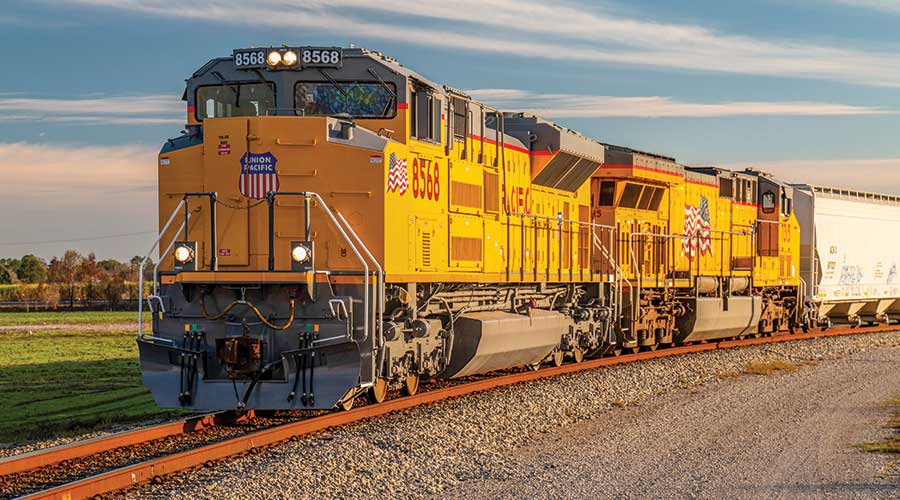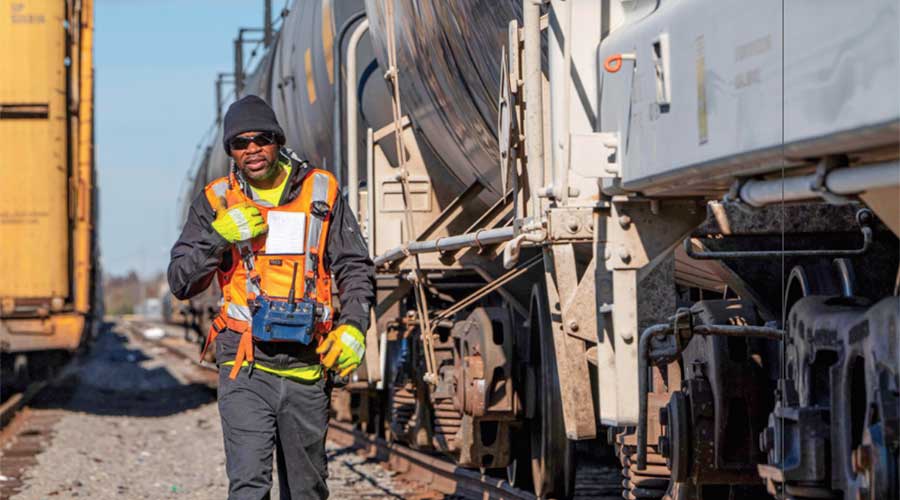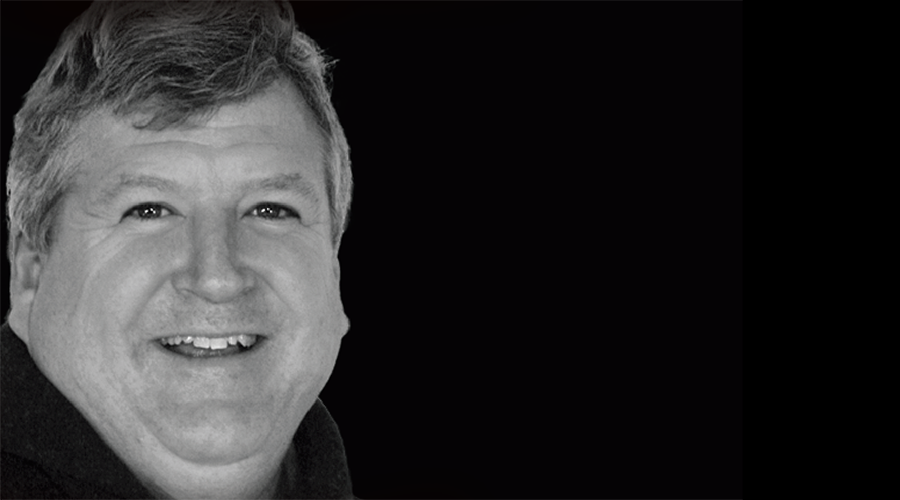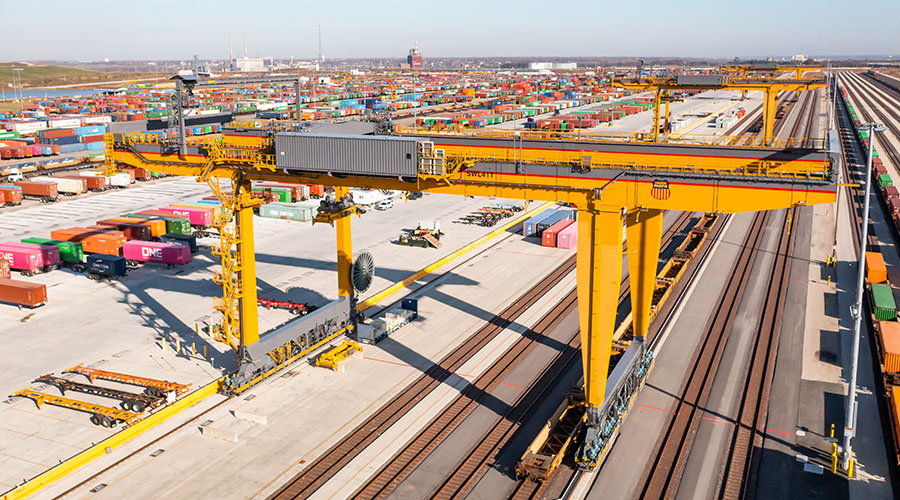Stay updated on news, articles and information for the rail industry
October 2012
Rail News: Union Pacific Railroad
Profile: Jim Young, Union Pacific Railroad (Progressive Railroading's 2012 Railroad Innovator Award winner)
— by Pat Foran, Editor
Service-sensitive rail leaders haven't given up the ghost on big-road nimbleness, and perhaps none has pursued that grail as relentlessly — or successfully — as Jim Young. Union Pacific Corp.'s chairman, Young has led a charge to make the Class I a customer-first railroad by emphasizing what's vital to most shippers: consistent operational performance and more tailored service.
After rising through UP's ranks in the 1980s and 1990s, Young was named president and chief operating officer in 2004, and took the Class I's CEO reins in late 2005. During the past decade, he helped convince UP's board to invest billions in the railroad to ensure it has the capacity to meet customers' needs and expectations. He also spearheaded a culture change designed to help North America's largest railroad hire and retain top talent, as well as keep current and future UP leaders engaged with employees and customers alike.
In March, Young took a medical leave from his president/CEO duties while he is being treated for diagnosed pancreatic cancer, but he continues to serve as chairman. And he continues to help keep the Class I — and its 25,000 customers — on the incremental improvement path.
Accordingly, Progressive Railroading has named Young the recipient of our 2012 "Railroad Innovator Award."
"He took a railroad that was very operating focused and, if you will, somewhat insular and focused internally, and invested heavily in the railroad to focus on the client. And he has led the entire company with him on the journey," says David Yeager, president and CEO of The Hub Group Inc., an intermodal marketing company and freight transportation management firm that does business with UP. "I've been in this business 37 years, and it's an incredible accomplishment to be able to create something like that. Jim made Union Pacific very nimble, not just to make the railroad better but because the customer deserves it."
The Road Not Taken
The seeds of his inclusive management style may have been sewn in a diverse neighborhood of South Omaha, Neb., where Young grew up. It's certainly where he developed his work ethic, which borders on legendary in rail circles.
Young says his father, who drove a truck for a living, was the hardest-working person he's ever known, getting up at 4 a.m. and working long hours to provide for his family. Young contributed, too; he managed a paper route starting at age 9. It was a tough gig in rough-and-tumble South Omaha; Young was robbed three times. But the experience, along with walking through the public housing projects on his way to play baseball, helped him sharpen his people skills, albeit "out of necessity," as he puts it.
Sports also helped Young become a better communicator and a better leader. As a quarterback, running back and safety for Omaha South High School's football team, he took his work ethic to another level.
"Others had more talent," Young says. "I had to work harder to play."
Young hoped to play at the next level. But after a semester at Wayne State College in northeastern Nebraska, he discovered that "everyone ran faster and hit harder." So Young enrolled at the University of Nebraska-Omaha (UNO) to study accounting and computer science. After one semester, he left school to work full time as a systems engineer at Northwestern Bell, where his responsibilities included right-of-way easement research and residential development planning.
At the phone company, Young was mentored by George Givler, who encouraged him to return to UNO. Givler helped structure Young's work hours so he could attend classes.
"George also said, 'Pick a field that you can get a job in,' which was very smart," Young says.
In 1978, seven years after starting his college odyssey, Young graduated from UNO with a degree in business administration. At 26, he was "broke and desperate for a job," he says.
Young vowed to take the first offer he got. He applied at Northern Natural Gas, a prominent Omaha-based company. He also applied at UP.
"The word on the street was that rail was a dying industry," Young says.
UP was the first to offer Young a job — it was on a Friday, he recalls — and he took it. When he returned home from UP the following Monday, he had a message waiting for him. Northern Natural Gas, too, had offered him a position. It figured, Young thought. But he'd already committed to UP.
"One thing you learn is that sometimes, things may seem like a negative at the time, but they turn out to be a positive," he says.
Northern Natural Gas soon would become part of a holding company that in the mid-1980s became Enron Corp. That Enron.
"Thank God I came to Union Pacific," Young says.
Applying Lessons Learned
In 1978, he began his UP career in the planning and analysis department. At that time, rail giant John Kenefick was at UP's helm, and Young took notice — as well as a few notes.
In Kenefick, he saw a great capital planner and strategic thinker, and an effective leader — not merely a visionary who saw things, but a seer who got things done. That Kenefick traveled the railroad overseeing track upgrades — and to express his appreciation to the forces in the field — also wasn't lost on Young.
"It was a great opportunity to really learn about the company," says Young. "I tell people here now, 'You may be in marketing, law, technology, but get out and learn as much as you can about the company.' A large company, if they do it right, can provide a lot of opportunities for people."
Young seized his opportunities at UP, rising to the position of vice president of customer service planning and quality in 1997 — right about the time UP was struggling with a service meltdown after the 1996 merger with the Southern Pacific.
"It was a pretty tough environment for people in customer service. We were literally forcing some customers out of business," Young says. "We learned some lessons there in how critical we are to them."
They would be lessons Young would never forget. Meanwhile, his UP star kept rising. In 1998, he was named senior VP and corporate treasurer of Union Pacific Corp. In late 1999, he became chief financial officer.
UP colleagues and customers alike knew where Young's career path was leading.
"You could just tell was going to be a good, solid leader," says Hub Group's Yeager, who met Young during his CFO days. "He has really well-grounded, good values. He's a great listener, he's very knowledgeable and very hard working. And his energy level is extraordinary."
In early 2004, UP Chairman and CEO Dick Davidson made it official, telling Young he was going to be the railroad's new president and chief operating officer.
"I wouldn't say it was a total surprise — I had been CFO, and had spent some time in the field with Dick," Young says. "It was a great opportunity for me."
Service: It's Expected
It also was a great challenge. In 2003, UP "stumbled again" on the service front, as Young puts it. From the mid-1990s through the early 2000s, UP and other railroads had cut employment rolls; in those days, "hiring" was a bad word on Wall Street. Meanwhile, talk of a baby boomer bulge in retirements was rampant in human resources circles, but that's about as far as the talk went. And when the early 2000s recession receded and rail traffic surged, UP and other roads were caught short of people. Rail service, and rail customers, suffered.
The service snarl-ups had to stop, says Young, who added "CEO" to his title in late 2006 and "chairman" when Davidson retired in early 2007.
"There was a need for capacity, a need for focus on safety, service, efficiency — everything that's important to customers," he says.
To be sure, capital investments were needed. So, from 2005 to 2009, UP devoted the most money it ever spent in a five-period on capital investments — $14.3 billion — to adopt technologies designed to avoid network bottlenecks, congested yards and improperly switched cars, as well as to expand capacity and add equipment.
"Jim understood that the industry was shifting from cost cutting and improving productivity to growing," says Association of American Railroads (AAR) President and CEO Ed Hamberger. "He was very aggressive with his board in getting approval to increase capex. He was putting steel back into the ground to meet customer expectations."
Moreover, a new transportation plan was designed for every train with built-in contingencies to account for unexpected demand upticks or severe weather. UP also created a pool of surge resources and developed new services tailored for specific markets.
Young and his team continued to push the investment envelope, budgeting at record capital expenditure levels in 2010, 2011 and 2012.
"We've learned the hard lessons. We need to be agile, resilient and have recoverability," as Young told Progressive Railroading in the summer of 2010. "Now, service is an expectation, not a question anymore."
The lessons learned weren't solely of the capital variety. The culture at UP also had to change. Like many companies in older, labor-intensive industries, the Class I had operated for years with a top-down management style. For the 25,000 UP employees hired during the past half-dozen years — and the new ones to come — that approach wasn't going to cut it.
"If people don't come to work everyday in a positive work environment, they are going to leave," Young says.
To Young, what was needed was an environment where leaders do what they say and say what they mean. Where leaders engage and listen to employees. Where teamwork is encouraged and mutual respect mandated. Where employees understand that they're directly responsible for job security and company growth because what they do impacts customers.
"You work at a company over time, it can get a little cynical — 'if this is the message this year, what will it be next year?'" says Young. "But it's been a consistent message here for the past six years."
Young delivered it during field visits, and while meeting with employees and fielding questions in open forums. He also conducted regular employee town hall sessions in Omaha and streamed a town hall in conjunction with quarterly earnings.
"With technology today, employees can express their views however they want — online, by email," Young says. "They're not shy talking about what matters to them."
Credit UP's many team and departmental leaders, about half of whom have risen through the Class I's ranks, for staying on message and meaning it, Young says. But others, including a few current UP execs and customers, cite Young for ensuring that the message continues to sink in.
"He has the ability to lead and get a groundswell of support as well as anybody I've ever seen," says Yeager, whose Hub Group in 2009 shifted its western U.S. container business from BNSF Railway Co. to UP, citing UP's improved intermodal service performance.
It helps that Young can see the big picture without losing sight of the details — and, more important, see it without losing sight of the people he works with, employees and customers alike, colleagues say. Hamberger recalls a December AAR board meeting at which directors typically assess the year that's about to end and approve the budget for the next one. Young had to leave the meeting early.
"The next morning, the phone rang. It was Jim," Hamberger says. "'Sorry I had to leave. But I just wanted you to know how much I appreciate your team's hard work. Please make sure they know how much I appreciate them.' He was so sincere. That goes a long way."
Young's message-sending skills also have been noticed in D.C. and on Wall Street.
"He's done a phenomenal job representing the industry in beating back the fights on re-regulation," says independent transportation analyst Tony Hatch. "All of the railroad CEOs shouldered it to some degree, but the investment community really thinks that Jim championed their cause the most effectively by articulating the need for the industry to earn its cost of capital, and what capex really means."
A Legacy In Progress
Change at UP has manifested itself in other ways during Young's tenure. In addition to breaking its own capex records the past three years, the Class I posted record earnings in 2010 and 2011. In second-quarter 2012, UP's Customer Satisfaction Index of 93 tied the all-time quarterly record and was one point better than 2Q 2011's number.
And unlike customers from the service meltdown era, shippers these days tell Young that the railroad is "making a positive difference" in their ability to grow their businesses.
"We are unquestionably the top railroad in the industry for service and reputation, almost a last-to-first type of story going back to the late 1990s," he says.
UP's recent successes made the railroad's 150th anniversary celebration this year that much sweeter.
"I wanted every employee to feel part of it this year," Young says. "The pride of our employees working here, the pride in what they do — it's just been great."
Young, who continues to receive treatment for his illness, just wishes he could have attended more anniversary events.
"The biggest thing I miss is employee engagement," he says. "Look at the diversity of the cultures and employees, and the territories we operate in. We really do reflect America."
In the meantime, Young, who turns 60 this month, will continue work on board governance, and strategic and succession planning issues.
"I plan to do that for at least the next few years," he says. "I feel good."
When asked what he'd like his legacy to be once he's finished building it, he says he hopes that when employees think of Union Pacific, they think of a great place to work, a place that they're proud of.
Young thinks some more, then adds:
"I'm obviously biased, but whenever I see a Union Pacific locomotive, I think about how important we are to the economy, to thousands of customers, to this country."
Of course, Young won't just take his word for it. He'll continue to engage UP employees and customers and try to get a dialogue going.
"If I'm at a diner, and I meet a locomotive engineer, I'll ask: 'When people ask where you work, and you say Union Pacific, what do they think about that? How do they feel about us?'" Young says. "Or, maybe I'll ask the waiter, 'What is your view of Union Pacific?' I never take it for granted."
And he never will, colleagues and friends say.
"He's always asking questions, trying to learn," Hub Group's Yeager says. "He's a great innovator."
Keywords
Browse articles on Jim Young Union Pacific Railroad rail innovation railroad innovator awardContact Progressive Railroading editorial staff.


 2025 MOW Spending Report: Passenger-rail programs
2025 MOW Spending Report: Passenger-rail programs
 Gardner steps down as Amtrak CEO
Gardner steps down as Amtrak CEO
 Guest comment: Oliver Wyman’s David Hunt
Guest comment: Oliver Wyman’s David Hunt
 Women of Influence in Rail eBook
Women of Influence in Rail eBook
 railPrime
railPrime







